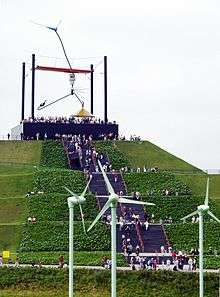AIPH
The International Association of Horticultural Producers (AIPH / IAHP) is an international organization dedicated to promoting horticultural producers and held the international garden / flora festivals or expositions.
AIPH aims to put flower, plant and landscaping services on a global agenda, with a vision to:
- Stimulate increased demand for ornamental trees, plants and flowers worldwide.
- Protect and promote the interests of the industry.
- Be an international hub for industry information and knowledge exchange.
- Lead best practice in ornamentals production
History
In 1948, amid strained relationships following the end of the Second World War, a group of representatives from the national grower associations of Western Europe came together in Zurich to form the Association Internationale des Producteurs de l’Horticulture (AIPH).
1990s
At least 4 events were held including the 1999 World Horticultural Exposition in Kunming, China and Expo '90 in Osaka, Japan.[1]
2000s
15 events were held in the 2000s including Floriade 2002 in Haarlemmermeer, Netherlands and an exhibition in Shenyang, China in 2006
2010s
Taipei 2010/2011
The 2010 Taipei International Gardening and Horticulture Exposition was held in Taiwan from November 6, 2010 to April 25, 2011 hosted by the Taipei City Government and the Taiwan Floriculture Development Association (TFDA). This was an A2/B1 classification event[2]
Venlo 2012
In 2012 the Floriade 2012 was held in Venlo. As with other Floriades this was an A1 classification event.[2]
Exhibitions
AIPH has been approving and regulating International Horticultural Expos, with its partners BIE (www.bie-paris.org), since 1960.
AIPH recognises five different categories of Horticultural Exhibitions, with the following table summarising the main differences between each of them.
| Categories | Official Name | Duration | Minimum Exhibition Area | Application |
| A1 | Large International Horticultural Exhibitions | 3 – 6 months | 50 Ha | 2 – 6 years before(BIE recognition required) |
| A2 | International Horticultural Exhibitions– Short Duration | 8 – 20 days | 15,000 m2 | More than 4 years before |
| B1 | Horticultural Exhibitions with International Participation – Long Duration | 3 – 6 months | 25 Ha | 7 – 3 years before |
| B2 | Horticultural Exhibitions with International Participation – Short Duration | 8 – 20 days | 6,000 m2 | More than 2 years before |
| A2/B1 | Horticultural Exhibition with International Participation – Long Duration | 3 – 6 months | 25 Ha | 7 – 3 years before |
This calendar shows both the approved exhibitions and those applied for http://aiph.org/current-events/
Membership and Committess
A list of AIPH members can be found here http://aiph.org/members/aiph-member-organisations/
All members have the right to sit on a Committee. The Standing Committees include:
- Green City
- Marketing and Exhibitions
- Novelty Protection
- Environment and Plant Health
Other active groups include:
- Statistics
- Science and Education
Relationships
AIPH maintains relations with other organisations in the field, including the Community Plant Variety Office (CPVO) of the EU and Ciopora, the International Association of Plants Breeders. In line with the International Union for the Protection of New Varieties of Plants (UPOV) – convention 1991, AIPH lobbies to maintain the rights of growers and to resist legislation that would reduce innovation in the sector. http://aiph.org/novelty-protection/
References
- ↑ Exhibitions, history Archived 15 October 2011 at the Wayback Machine.. Retrieved 8 January 2010.
- 1 2 "AIPH | Exhibitions, history". Archived from the original on 15 October 2011. Retrieved 27 November 2013.
